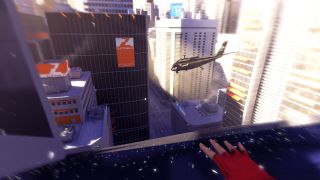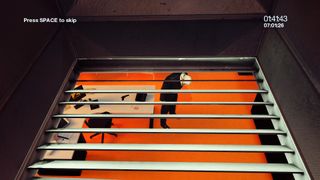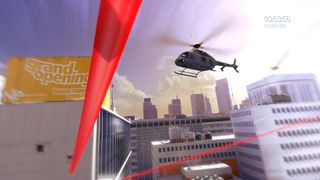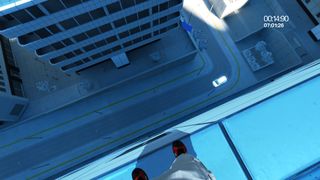Mirror's Edge is still the undisputed queen of parkour
Taking a leap of Faith.

This article first appeared in PC Gamer magazine issue 363 in November 2022, as part of our 'Reinstall' series. Every month we load up a beloved classic—and find out whether it holds up to our modern gaming sensibilities.
You don’t often think about running in games, do you? Hold W to go forwards, maybe tap shift if you’re really hoofing it. Then there’s Mirror’s Edge, a game so committed to putting you in the free-running shoes of leading lady Faith Connors that you can practically feel the soles wearing out with each jump, slide, and wallrun. Parkour might not be as cool now as it was in 2008, but over a decade later, Faith is still running circles around the competition.
Mirror’s Edge is a first-person parkour-’em-up from Battlefield creator Dice, who briefly put the guns away to make a game where running away was as dense and satisfying as any FPS gunfight. It’s a game about running and vaulting and sliding your way across rooftops at blistering speed, even if the occasional naff brawl puts the brakes on things every now and then.
I’ve always been a sucker for good movement. Jet Set Radio Future set the template as far as I’m concerned, its cel-shaded skates kicking off a lifetime’s fascination with the ways games tackle traversing a 3D space – be it trying to master Quake’s bunnyhops, to conserving speed through a tactical buttslide in Apex Legends. Games where you could strip out everything but the character controller and still have fun running and jumping and sliding around.
But Mirror’s Edge has a physicality to it that hasn’t really been matched before or since. You are Faith, in a tangible, meaningful way. Plenty of games show you your characters legs when you look down, but Mirror’s Edge gives you such a powerful sense of what Faith’s body is doing with each move. Her hair even sways with the wind, a needlessly frivolous effect considering you never leave a first-person perspective, and yet grounds you as a physical entity within the world.

You feel each footstep as you kick up to speed, and feel the weight of her body as you bounce off walls and vault over pipes. Where Titanfall’s wallruns are fast and effortless, Mirror’s Edge forces you to feel the gravity of the physics-defying reality of sprinting sideways.
Mastering Faith’s movements takes real work, and I found myself stumbling over every step and ledge. But it didn’t take long for the muscle memory to kick in. See, back in school, a pal and I used to race each other across the game’s rooftops, spending weeks at a time shaving fractions of a second off each other’s paces on just the fi rst time trial map.
We were speedrunning, long before I was really conscious of what speedrunning was, and a few levels into this revisit all the old tricks came rushing back. The sidestep jump that pulls you from a standstill to a full-speed sprint. The cheeky wee kick at the end of a wallrun to give you a few frames of coyote time. Mirror’s Edge is crammed with techniques that blur the line between intended play and full-on, boundary-breaking speedrun strats.
The biggest gaming news, reviews and hardware deals
Keep up to date with the most important stories and the best deals, as picked by the PC Gamer team.
Getting good at running also helps you avoid the game’s infrequent shootouts, which flatly aren’t great. Yes, I adore that your embodiment of Faith means guns do feel awkward in her hand (she’s a runner, not a soldier), but Mirror’s Edge is ultimately not brave enough a game to forgo fighting entirely – and when scraps happen, they’re a clumsy mix of awkward fi rst-person brawling and haphazard shooting.
Urban Flight

That shooting is joined by the game’s story as aspects of the game that feel sorely lacking. Mirror’s Edge’s plotting feels like an afterthought, a wholly uninspiring conspiracy told through animated cutscenes that feel rushed and disconnected. Your cop sister’s been framed for murder, see, and in trying to clear her name Faith gets roped into a tangle of corporate scheming to take over the city’s police force. Mirror’s Edge has a neat set-up with its illegal, free-running Deliveroo gangs, but never really does anything interesting with it.
Here’s the thing: I think Mirror’s Edge is probably the best Matrix videogame to date. Think about it. You’re sprinting through hallways and rooftops across a sprawling, non-distinct city, fleeing faceless cops at every turn. You have your very own operator guiding you through each job, telling you exactly which alley to turn down and which door to punch through to best evade the law. There’s even a wee bit of bullet time, though it mostly operates as a tool to make disarming cops a little easier.
As cool as she is though, it’s the city, not Faith, that’s the main character of Mirror’s Edge. Never named, vaguely American but geographically impossible to pin down, the city has such a sterile sense of character. I can’t stress enough how good this leaves Mirror’s Edge looking, a vibrant art direction lending its city a timeless look.

The story might be clumsy, but you don’t need characters and dialogue to tell that this is a deeply post-9/11 world of encroaching surveillance and rampant privatisation. A dystopia painted in clean white concrete, broken only by stark, garish signs for energy drinks and private security firms.
Corporate hellscapes are hardly new for cyberpunk. But Mirror’s Edge never quite crosses that line into being true cyberpunk, modelling its architecture off 20th century high-rises and more contemporary monstrosities. It avoids a trap its own sequel fell into, with Mirror’s Edge: Catalyst’s City of Glass offering a more fantastical metropolis – one that’s so sparkling and clean that you never get the sense the city was anything other than brand new.
As you descend through concrete canals and back alleys, Mirror’s Edge’s city gives you a strong sense that there used to be something here. At least, before the city council stumbled upon a warehouse full of white paint.
Redline
That starkness serves a purpose too. One of Mirror’s Edge’s smarter ideas was ‘runner vision’ – and while the name implies a Witcher or Arkham-esque mechanic that desaturates the screen, highlights interactive objects and maybe slows down time, Dice chose a more subtle approach.
Instead, runner vision applies a sharp red tint to your path through a level, screaming against the desaturated whites and greys of the rest of the map. Which door to open, which pole to climb, while box to spring-jump off. It allows the game’s levels to be dense without leaving the player utterly lost. Can’t work out where to go? Just follow the red.
Runner vision can be turned off, of course, but it’s important to note that while runner vision will guide you down the most direct path, it’s often not the fastest. It’s always worth keeping an eye out for riskier routes that might shave seconds off your time. A long pole climb might be averted by wall-bouncing off an exterior vent onto a series of AC units, and only a chump would use the stairs when there’s a perfectly precarious fence to hop.

Mirror’s Edge’s neighbourhoods are dense with this kind of detail, with time trials reworking even the smallest blocks into complex parkour playgrounds. It might take seconds to sprint across a few rooftops to the RP&A building in the game’s first chapter, but you’ll spend hours trying to complete a loop around just one of those building’s billboards.
It works because, fundamentally, Mirror’s Edge is still linear. The idea of an open city where you could free-run anywhere is still tempting, even now, but it’s this guiding that keeps Faith’s movements feeling fast and tight. Every jump, every wall, every fence has to be carefully considered. Every level gets to find its own route without trying to fi t within a greater urban structure.
Catalyst made Mirror’s Edge busier. Not only with an open world, but with progression trees, fussier combat, a wider cast of characters and more stakes. But Mirror’s Edge never needed any of that fuss. It’s a game about running, pure and simple. About hearing the wind rush past your ears as you pound ground, carving a route though a concrete jungle. It’s expression through movement, an encapsulation of what traversal in 3D space can mean. This runner might be old, but they’re still the best in the game.

20 years ago, Nat played Jet Set Radio Future for the first time, and she's not stopped thinking about games since. Joining PC Gamer in 2020, she comes from three years of freelance reporting at Rock Paper Shotgun, Waypoint, VG247 and more. Embedded in the European indie scene and a part-time game developer herself, Nat is always looking for a new curiosity to scream about—whether it's the next best indie darling, or simply someone modding a Scotmid into Black Mesa. She also unofficially appears in Apex Legends under the pseudonym Horizon.
Most Popular


